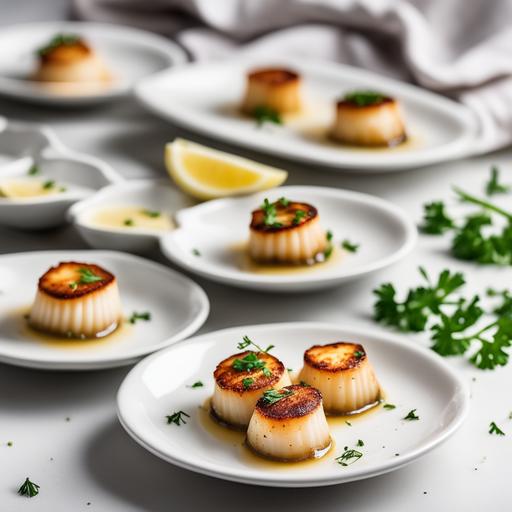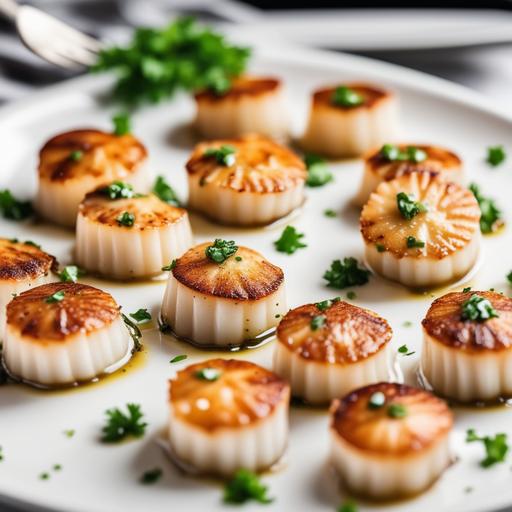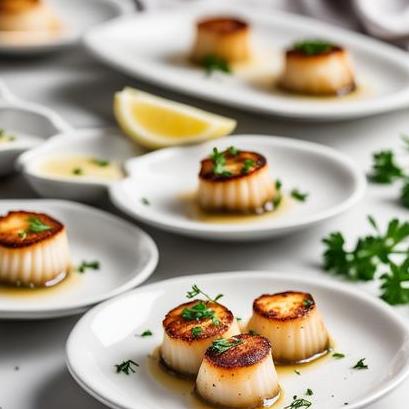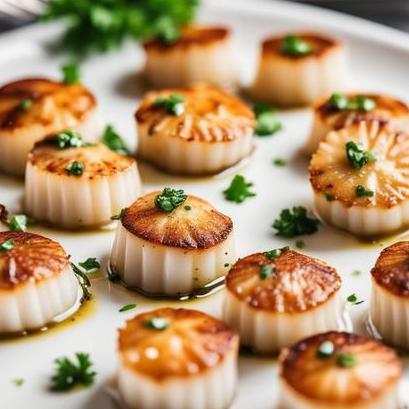Scallops Air Fryer Recipe: Gourmet Delights In Minutes

The air fryer is a game-changer in the culinary world, allowing you to create delicious and healthy dishes in a fraction of the time. If you’re a seafood lover craving succulent scallops, then this comprehensive guide is perfect for you. We will delve into the science behind cooking scallops, share culinary insights, provide tips and variations, and ultimately present you with a mouthwatering scallops air fryer recipe. Get ready to indulge in gourmet delights effortlessly!
Understanding the Science: Why Air Frying is Perfect for Scallops
To fully appreciate the magic of air-fried scallops, it’s essential to understand the science behind this cooking method. Air fryers utilize a powerful circulating hot air mechanism, similar to a convection oven, to cook food evenly and with enhanced crispiness. As scallops are delicate and naturally high in moisture, the air fryer’s dry and hot cooking environment is ideal for achieving a delectable sear without drying them out.
Selecting the Best Scallops for Your Dish
When it comes to selecting scallops, freshness is key to achieving the perfect texture and flavor. Opt for fresh scallops whenever possible, as they have a sweet, delicate taste that intensifies when cooked. Look for scallops that are plump, moist, and odor-free, with a creamy or slightly pinkish hue. Avoid any scallops that appear slimy, have a strong fishy odor, or are discolored.
Cleaning and Preparing Scallops

Before diving into the preparation process, it’s crucial to properly clean and prepare your scallops. Start by rinsing them under cold water to remove any excess sand or grit. Pat them dry gently using paper towels, allowing the scallops to maintain their moisture.
Culinary Tips for Scallops in the Air Fryer

To achieve scallop perfection in your air fryer, consider the following culinary tips:
-
Seasonings: Keep the seasoning simple to allow the natural sweetness of the scallops to shine. A sprinkle of salt, pepper, and a touch of garlic powder or lemon zest would suffice.
-
Oil: While air frying requires minimal oil, lightly brushing your scallops with olive or avocado oil helps promote a beautiful sear and prevents sticking.
-
Spacing: Ensure that the scallops are evenly spaced in your air fryer basket or tray. This allows for proper air circulation and ensures an even cook.
-
Preheating: Preheat your air fryer before cooking the scallops. This ensures that the cooking temperature is consistent from the start, resulting in a perfectly cooked batch.
-
Sealing the Juices: For extra juicy scallops, try searing them quickly in a hot skillet before transferring them to the air fryer. This step locks in the moisture, preventing any loss during the cooking process.
Achieving the Ideal Doneness

Cooking scallops to the perfect doneness is crucial to enjoy their tender texture and delicate flavor. Here’s how you can ensure your scallops are perfectly cooked:
-
Cooking Time: As scallops cook quickly, it’s important to keep a close eye on them. Typically, scallops require around 6-8 minutes in the air fryer at a temperature of 375°F (190°C). However, cooking times may vary depending on the size and thickness of the scallops.
-
Internal Temperature: Aim for an internal temperature of 120°F (49°C) for medium-rare and 140°F (60°C) for medium. Be careful not to overcook the scallops, as they will become rubbery and lose their delicate taste.
Scallops Air Fryer Recipe: Classic Seared Scallops with Lemon Zest

Now that you’re equipped with the knowledge and tips to succeed, let’s dive into an irresistible scallops air fryer recipe.
Ingredients:
- 1 lb (450g) fresh scallops
- 1 tablespoon olive oil
- 1 teaspoon salt
- 1/2 teaspoon black pepper
- 1/2 teaspoon garlic powder
- Zest of 1 lemon
- Lemon wedges (for garnish)
- Fresh parsley (for garnish)
Instructions:
Step 1: Preparing the Air Fryer
- Preheat your air fryer to 375°F (190°C) for about 5 minutes. This step ensures consistent and efficient cooking.
Step 2: Seasoning the Scallops
- In a small bowl, combine the salt, black pepper, and garlic powder.
- Pat the scallops dry with a paper towel, then lightly brush them with olive oil.
- Sprinkle the seasoning mixture evenly over the scallops, ensuring they are coated on all sides.
Step 3: Air Frying the Scallops
- Place the seasoned scallops in the air fryer basket, making sure they are evenly spaced for proper air circulation.
- Cook the scallops in the air fryer for 6-8 minutes, flipping them halfway through the cooking time.
- Keep a close eye on the scallops to prevent overcooking. They should turn golden brown with a caramelized crust while remaining tender and juicy in the center.
Step 4: Serving
- Once cooked, carefully remove the scallops from the air fryer using tongs.
- Sprinkle the lemon zest over the cooked scallops, allowing the citrusy aroma to enhance their flavor.
- Serve the seared scallops immediately with lemon wedges and garnish with fresh parsley for an added touch of freshness.
Variations and Serving Suggestions
While the classic seared scallops recipe is undeniably divine, feel free to explore various flavors and presentations. Here are some variations and serving suggestions to inspire your culinary creativity:
-
Garlic Butter Scallops: Replace the olive oil in the recipe with melted garlic butter for a rich and indulgent twist. Drizzle any remaining garlic butter over the cooked scallops for added decadence.
-
Asian-Inspired Scallops: Season the scallops with soy sauce, sesame oil, and a touch of ginger. Serve them over a bed of steamed jasmine rice with a side of stir-fried vegetables for an Asian-inspired feast.
-
Scallop Skewers: Thread the seasoned scallops onto skewers and cook them in the air fryer. Serve them as an appetizer or alongside a fresh salad for a delightful and elegant presentation.
-
Scallop Tacos: Create a fusion dish by placing the seared scallops in warm corn tortillas, accompanied by avocado slices, shredded lettuce, and a squeeze of lime juice. Sprinkle with chopped cilantro for an explosion of flavors.
Final Thoughts
Cooking scallops in the air fryer opens a world of possibilities for seafood enthusiasts. This article has provided you with a comprehensive understanding of the science behind air frying scallops, as well as culinary tips, a delicious recipe, and creative serving suggestions. With this newfound knowledge, embrace your inner chef and indulge in gastronomic delights without the hassle. Enjoy the crispy sear, delicate texture, and mouthwatering flavors that perfectly cooked scallops in the air fryer offer. Bon appétit!
Sources
FAQS On Scallops Air Fryer Recipe
How Do I Make Crispy Air Fryer Scallops?
To make crispy air fryer scallops, pat dry the scallops and season them with salt and pepper. Preheat the air fryer to 400°F and place the scallops in a single layer. Cook for 6-8 minutes, flipping halfway, until they are golden brown and crispy.
Can I Use Frozen Scallops In An Air Fryer?
Yes, you can use frozen scallops in an air fryer! Just make sure to thaw them completely before cooking and pat them dry to ensure even cooking and a crispy texture.
What Other Seasonings Can I Use For An Air Fryer Scallops Recipe?
You can experiment with different seasonings to add more flavor to your air fryer scallops. Some popular options include garlic powder, paprika, Italian seasoning, or lemon pepper.
How Long Should I Cook Scallops In An Air Fryer?
The cooking time for scallops in an air fryer can vary depending on their size and the temperature of the air fryer. Generally, it takes about 6-8 minutes at 400°F to cook scallops until they are golden brown and cooked through.
Can I Use Butter Instead Of Oil For An Air Fryer Scallops Recipe?
Yes, you can use melted butter instead of oil to coat your scallops before air frying. This will add a richer and more buttery flavor to your scallops.
What Is The Best Type Of Scallops To Use For An Air Fryer Recipe?
Fresh, dry-packed scallops are the best type to use for an air fryer recipe. Avoid using wet scallops as they have been soaked in a preservative solution that can affect the texture and taste.
Can I Cook Other Seafood In An Air Fryer Besides Scallops?
Yes, you can cook a variety of seafood in an air fryer, including shrimp, fish fillets, and even crab cakes. Just make sure to adjust the cooking time and temperature accordingly for each type of seafood.


